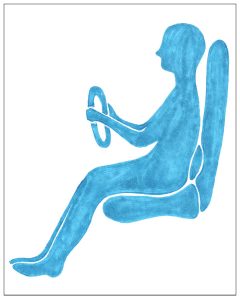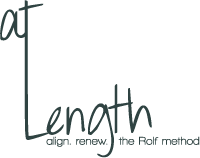3. Driving yourself crazy?
 Many of us here on the East Coast spend hours commuting to or traveling for work every day. Poor driving posture can result not only in increased back and neck strain, but also accelerated overall fatigue and increased reaction time. On the other hand, driving with good posture reduces strain on your spine and joints, prevents muscle fatigue and helps maintain alertness.
Many of us here on the East Coast spend hours commuting to or traveling for work every day. Poor driving posture can result not only in increased back and neck strain, but also accelerated overall fatigue and increased reaction time. On the other hand, driving with good posture reduces strain on your spine and joints, prevents muscle fatigue and helps maintain alertness.
Here are a few guidelines for better driving posture that can help you arrive at your destination relaxed and alert:
- Sit with your spine straight and you lower back pressed into the set back to stabilize your pelvis. TIP: Extra lower back support (a rolled up towel or a small, firm pillow) at the back of the waist will help maintain your lumbar curve and keep your pelvis from tilting forward.
- Lower your steering wheel to the proper height, so you don’t have to lift your upper arms to reach it. Your hands should be a little lower than your shoulders.
- Lower your hands on the steering wheel. Due to new steering technology and the use of airbags, “10 and 2” is not longer recommended. Now traffic officials say that drivers should hold the wheel at a “9 and 3” position or lower. This allows your arms to hang naturally from your shoulders — vertically down the side of your body.
- Recline your seat back to a 10 to 15% angle to stabilize your upper body. TIP: Adjust your rearview mirror when you are sitting tall — then if you slouch or slide forward, you’ll notice it when you check your mirror!
- Move your seat slightly forward. Bent knees reduce hamstring tension. TIP: Don’t drive with your wallet in your back pocket — it can tilt your pelvis and spine to one side and exert pressure on the sciatic nerve.

- Adjust your head rest so your neck is in a straight line with your spine whenever you head is resting against it, keeping your chin level, not tilted up.
- Be sure your weight is evenly distributed on both of your buttocks and that you are sitting on your “sitz bones”. Don’t let yourself lean to the right side to rest your arm on an armrest or console that is NOT properly positioned. A firm seat cushion allows the body’s weight to rest squarely on the sitz bones, rather than on the tail bone! TIP: If your leather or vinyl seats cause your hips to continually slide forward, consider purchasing a fabric seat cushion for better friction.
- Relax your shoulders, lift your chest and drive carefully!
Next time: “Make your workplace work for you!”

